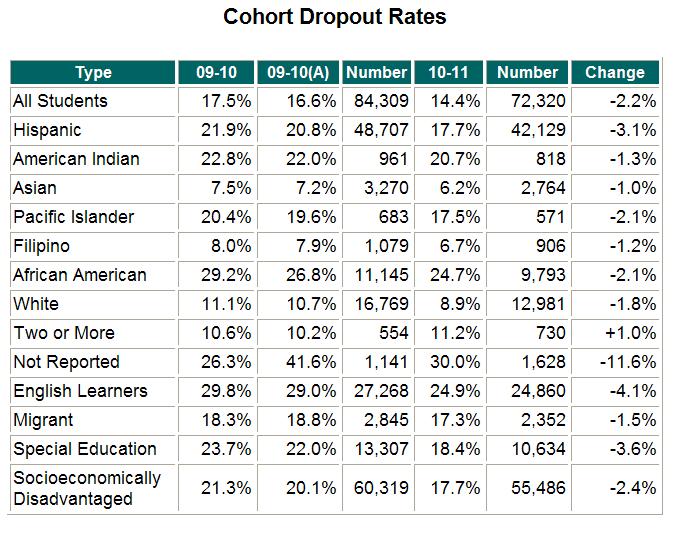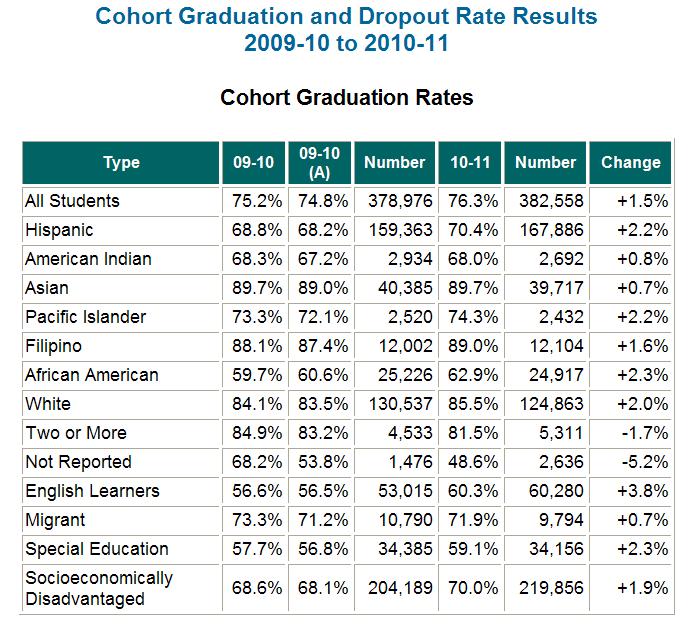State Schools Chief Tom Torlakson Reports Climb in Graduation Rates for California Students
SACRAMENTO—Graduation rates among California’s public school students are climbing and dropout rates are falling, with the biggest gains being made among English learners and the state’s largest minority groups, State Superintendent of Public Instruction Tom Torlakson announced today.More than three quarters, or 76.3 percent, of students who started high school in 2007 graduated with their class in 2011. That is up 1.5 percentage points from the 2010 graduation rate. Larger gains were seen among Hispanic and African American students at 2.2 and 2.3 percentage points respectively, with the biggest increase being among English learners at 3.8 percentage points. The graduation rate for socioeconomically disadvantaged students climbed nearly 2 percentage points, from 68.1 to 70 percent.
“Every graduate represents a success story in one of the most effective job and anti-poverty programs ever conceived, our public schools,” Torlakson said. “These numbers are a testament to the hard work of teachers and administrators, of parents and, most of all, of the students themselves. While they are a great illustration of all that is going right in California schools, they should also remind us that schools need our support to continue to improve so that every student graduates prepared for college, a career, and to contribute to our state’s future.”
Beyond the 76.3 percent graduation rate and the 14.4 percent dropout rate, the remaining 9.3 percent are students who are neither graduates nor dropouts. Some are still enrolled in school (8.6 percent). Others are non-diploma special education students (0.4 percent), and some elected to pass a high school equivalency exam.
Graduation and dropout rates for counties, districts, and schools across California were calculated based on four-year cohort—referring to this particular group of students—information using the state’s California Longitudinal Pupil Achievement Data System (CALPADS). This is the second time this four-year cohort information was collected, making this the first time that it can be compared year to year. With two years of data, the cohort rates will now be used to determine whether schools have met their targets for increasing the graduation rate for the Adequate Yearly Progress reporting under the federal school accountability system. The 2009-10 rates were also adjusted as a part of this data release (marked “A” in the tables below) to include only those students who were first-time ninth graders in the 2006-07 school year.
The new cohort dropout rate is calculated for high school students, grades nine through twelve. However, there are also significant numbers of students who drop out of school during the middle school years.
“Our research shows that chronic absence from school, even as early as kindergarten, is a strong indicator of whether a child will drop out of school later,” Torlakson said. “The dropout rate shows there’s still much work to be done, particularly to address the needs of disadvantaged and minority students. We must build on our work with parents and communities in the earliest years to pave the way for kids to succeed in school.”
CALPADS has made great strides since an independent oversight consultant was critical of the initial release of the system in 2009. In its latest report, the same independent oversight consultant concluded, “The CALPADS project is presently in the healthiest state of its history.”
To view and download state, county, district, and school graduation and dropout rates, please visit the CDE DataQuest Web site at DataQuest. Reporters are encouraged to use caution when comparing education rates among individual schools and districts; some, such as county office schools, alternative schools or dropout recovery high schools, serve only those students who are already at the greatest risk of dropping out, compared with the broader population at traditional high schools.





